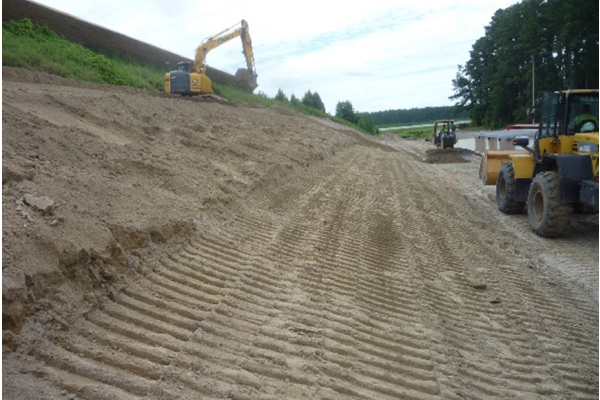Lead Removal Action / Berm Restoration at the Known Distance (KD) Rifle Range, Marine Corps Air Station (MCAS) Cherry Point, NC – NAVFAC Mid-Atlantic
KGS conducted a Remedial Action providing lead recovery, berm reconstruction, and erosion mitigation to mitigate migration of lead-impacted and to provide long-term sustainability for the KD Rifle Range at the MCAS Cherry Point Range Complex.
Prior to fieldwork, KGS participated in kick-off and partnering meetings with NAVFAC and USMC Range Management Department (RMD). Various project plans were completed, and an initial topographical survey of the deteriorated berm was conducted prior to lead recovery/soil excavation.
Site preparation included installation of erosion and sediment (E&S) controls in accordance with applicable permits and best management practices (BMPs). As part of the berm soil excavation and Munition Debris (MD) collection, KGS excavated the and removed the top 6 feet of the berm to provide a uniform stable surface to place and compact the backfill required for the final configuration. KGS completed Munitions and Explosives of Concern (MEC) clearance of the entire berm footprint.
All excavated soil was transported to the laydown area for mechanical sifting to remove MD and associated lead fragments and provide recyclable backfill “ricochet-free”. The berm soils were sifted through a 0.25” screen via a mechanical sifter and inspected by UXO technicians for projectiles and other unacceptable debris. All MD was placed in 55-gallon drums, profiled, and sent to a metals recycling facility.
Berm reconstruction activities included placement of recycled sifted berm soils into 12” lifts and compacted to 95% density. Off-site borrow source (clean fill) was tested, submitted, and approved to supplement the recycled sifted berm soil to obtain the designed grade. Following backfilling operations, the ballistic cellular-confinement system installation (GeoWeb) was assembled and installed to stabilize the face of the berm. The benefit to reconstructing the berm and use of specialized soil doubled the expected lifecycle. Locally grown sod was installed and anchored on the berm face to fully restore the KD range berm. Upon completion for field work, an After-Action Report (AAR), including as-builts, GIS data, and a final ballistic ricochet hazard analysis, was submitted.

